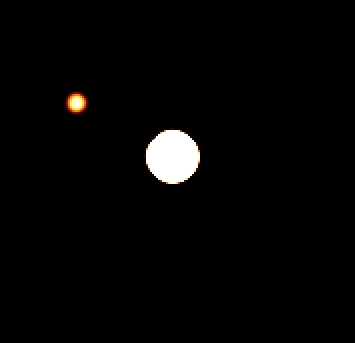
|
Explanation: Eugenia is an asteroid with a moon! This animation was constructed from infrared discovery images of the Eugenia-moon system taken in November 1998 using the Canada-France-Hawaii Telescope (CFHT). Main belt asteroid Eugenia, represented here as a central white patch, is a mere 215 kilometers in diameter. Its moon, seen at 5 separate positions around a clockwise orbit, is estimated to be 13 kilometers wide. An adaptive optics system was used with the CFHT, located atop Mauna Kea, Hawaii, to counteract the blurring effect of Earth's atmosphere making possible this premier discovery from a ground-based telescope. Only one other asteroid-moon system is known. Dactyl, moon of the asteroid Ida, was discovered by the Galileo spacecraft during a 1993 flyby.
Eugenia's moon has a nearly circular orbit with a radius of 1,190 kilometers which it completes once in 4.7 days. The orbit appears oval-shaped because it is tilted at a 45 degree angle to the line-of-sight. Knowing the moon's orbit allows astronomers to calculate the asteroid's mass. Combining mass and size determines the asteroid's density, which in this case gives a surprising result - Eugenia is found to have a density only 20% greater than water. The low density suggests that Eugenia itself is a porous "rubble pile" of rocks or composed mostly of water-ice with only a little additional rocky material.
|
January February March April May June July August September October November December |
| ||||||||||||||||||||||||||||||||||||||||||||||||
NASA Web Site Statements, Warnings, and Disclaimers
NASA Official: Jay Norris. Specific rights apply.
A service of: LHEA at NASA / GSFC
& Michigan Tech. U.
Based on Astronomy Picture
Of the Day
Publications with keywords: Moon - adaptive optics - asteroid
Publications with words: Moon - adaptive optics - asteroid
See also:
